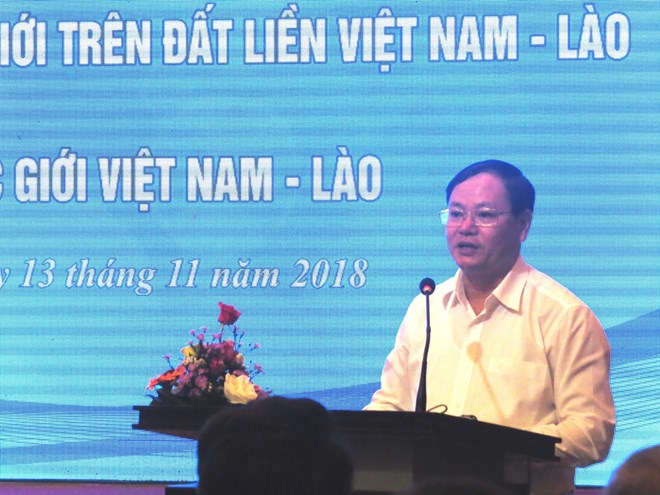
A conference was held in Dong Hoi city, in the central province of Quang Binh, on November 13 to look into the implementation of certain documents on the Vietnam-Laos borderline, border markers, and border gates.

Vice Chairman of the Quang Binh provincial People’s Committee Le
Minh Ngan addresses the conference in Dong Hoi city on November 13 (Photo:
VNA)
On March 16, 2016, the Vietnamese and Lao Governments signed a protocol on the
countries’ borderline and border markers, along with an agreement on
regulations for land border and border gate management. These documents took
effect on September 5, 2017.
Addressing the conference, Vice Chairman of the Quang Binh provincial People’s
Committee Le Minh Ngan said the treaties are important legal documents that
fully and precisely describe the borderline and border markers’ locations,
while also specifying the responsibility and obligations in managing and
protecting the shared boundary of each side. They have helped to improve border
management and build a Vietnam-Laos border of peace, stability, cooperation,
and development for the sake of the two peoples.
He noted that in order to effectively realise these documents, authorities of
all levels and the general public must come to understand their terms,
implement measures, and promote a high consensus in the matter, especially
among border residents, in the management and protection of the borderline and
border markers.
An official of the western border division of the foreign ministry’s National
Boundary Commission informed participants on the Vietnam-Laos and
Vietnam-Cambodia border situation, some noteworthy issues in local land border
management, and the realisation of the treaties.
Vietnam and Laos share a border of nearly 2,340 km that runs across through 10
Vietnamese provinces: Dien Bien, Son La, Thanh Hoa, Nghe An, Ha Tinh, Quang
Binh, Quang Tri, Thua Thien-Hue, Quang Nam, and Kon Tum.
The line also appears in 10 Lao provinces: Phongsaly, Luang Prabang, Houaphan,
Bolykhamsay, Khammoune, Savannakhet, Salavan, Xiengkhouang, Sepon, and Attapeu.
The two countries marked the completion of a project on increasing and
upgrading border markers along their boundary in March 2016.
Under the project, 1,002 markers and stakes were planted along the joint
border, compared to only 199 markers before 2008. These were increased in
necessary areas to further clarify the border in reality. Meanwhile, existing
markers, especially those at border gates, were upgraded to create a system of
solid and modern border markers, officials said.
Source: VNA
In the spirit of "Party members go first, the people follow”, all households of Party members in the Doan Ket sub-region in Da Bac town, Da Bac district, voluntarily removed gates and fences, and donated land when the road expansion project passed through their properties. Inspired by their example, 68 households in the sub-region quickly followed suit, contributing over 1,400 sq.m of residential and perennial cropland to widen the main road through the residential area. The exemplary role of Party members in Doan Ket stands as a shining example of studying and following President Ho Chi Minh’s thought, morality, and lifestyle.
The Hoa Binh provincial People's Committee held a monthly meeting on May 29 to assess the implementation of socio-economic development tasks in the first six months of 2025, the progress of key projects, and some other important issues.
During his lifetime, President Ho Chi Minh always expressed his deep affection and special concern for children and youth. He once emphasized: "Caring for and educating children well is the responsibility of the entire Party and the entire people”; "First of all, the family (i.e. grandparents, parents, siblings) must do this job well”. "the Party Committees…, the Children’s Committee, the Youth Union, the education sector, and all related organizations must have specific plans to ensure children grow healthier and more progressive”. His teachings has been remaining valuable and serving as the guiding principles in the work of protecting, caring for, and educating children. In line with this ideology, Hoa Binh Province has continuously been prioritizing and investing resources in the well-being of children in recent years.
Mr. Nguyen Phi Long, the alternate Member of the Party Central Committee and Secretary of the Provincial Party Committee chaired the meeting of the Standing Committee of the Provincial Party Committee to provide opinions on several investment projects within the province. There was the attendance of Ms. Bui Thi Minh, the Permanent Deputy Secretary of the Provincial Party Committee and Chairwoman of the Provincial People’s Council; Mr. Bui Đuc Hinh, the Deputy Secretary of the Provincial Party Committee and Chairman of the Provincial People’s Committee and other members of the Standing Committee; the leaders from other departments, agencies, and some localities.
The Standing Board of the Vietnam Fatherland Front (VFF) Committee of Hoa Binh province held a meeting on May 28 to honour outstanding village elders, village heads, and reputable individuals from local ethnic minority and religious communities.
In mid-May, the provincial Museum organised an exhibition named "Duoi la co Dang Cong san Viet Nam quang vinh” (Under the flag of the glorious Communist Party of Vietnam). This meaningful activity took place in the joyful atmosphere to celebrate the country's major holidays and the Party congresses at all levels for the 2025-2030 term, towards the 14th National Party Congress.



